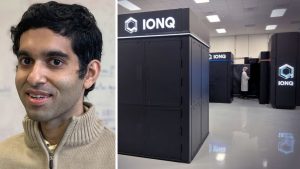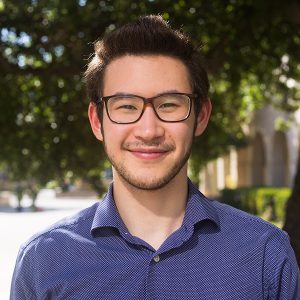
UW ECE Assistant Professor Rahul Trivedi was featured in a GeekWire article on quantum computers and the uncertainties of its future. The IonQ Forte quantum system (right) is roughly the same size as a standard data center cabinet. IonQ photo courtesy of GeekWire
Adapted from an article by Alan Boyle | GeekWire
Do full-fledged quantum computers already exist, or will it be a decade before they come into being? Will they have to be the size of a football field? A data center cabinet? A microwave oven?
It seems as if the more you talk to computer scientists involved in the quantum computing quest, the less certain the answers become. It’s the flip side of the classic case of Schrödinger’s Cat, which is both dead and alive until you open the box: Quantum computers could be regarded as already alive, or not yet born.
For example, Microsoft is working on a full-stack quantum computer based on an exotic technology that’s expected to come to fruition on the time scale of a decade. Maryland-based IonQ has been making its quantum systems commercially available since 2019, and plans to start building next-gen quantum computers next year at a research and manufacturing facility in Bothell, Wash. Meanwhile, D-Wave Systems, which is headquartered near Vancouver, B.C., has been selling quantum hardware for more than a decade.
So are quantum computers ready for prime time? Researchers say that they’re not, and that the timeline for development is fuzzy. It all depends on how you define quantum computers and the kinds of problems you expect them to handle.
“There’s always a subtlety in generating these estimates, because no one has experimentally demonstrated a working logical qubit, be it IonQ or Microsoft or any of the experimental platforms,” said Rahul Trivedi, an assistant professor at the University of Washington Department of Electrical & Computer Engineering who specializes in quantum systems.
Ironically, or appropriately, quantum noise plays a big part in the uncertainty. “A lot of these estimates are made based on noise models,” Trivedi said. “People believe that they work, and they describe their experiment quite well. But then you scale up your experiments, and you start figuring out deficiencies in your noise models, and then you update them, and all of these numbers keep on changing very rapidly.”
“In many of these problems, you’re not really looking for a very precise quantitative answer. You’re not looking for a number, but rather a trend.” – UW ECE Assistant Professor Rahul Trivedi
Questions about qubits
In contrast to the classical approach to computing, which relies on the well-understood manipulation of ones and zeroes, quantum computing is based on the weird properties of quantum physics — where a single quantum bit, also known as a qubit, can represent multiple values until the results are read out.
Big tech companies such as Microsoft, Google, IBM and Intel are trying to harness superconducting circuits to create their qubits, while other companies including IonQ and Quantinuum are making use of trapped ions instead. D-Wave is going with a different approach called quantum annealing, which applies quantum methods to special types of problems
The number of qubits contained in a processor is often used as a metric for progress in the quantum quest. Last November, for example, IBM announced that it created a 433-qubit processor called Osprey, with the goal of surpassing 4,000 qubits by 2025.
But researchers draw a distinction between physical qubits, the raw material for quantum computations, and logical qubits — that is, the reliable building blocks for such computations. Because quantum systems are inherently noisy and subject to errors, building one logical qubit for a fault-tolerant quantum computer could require combining as many as 1,000 physical qubits.
Microsoft’s team estimates that a quantum computer will require a million physical qubits to correct errors and achieve an advantage in solving problems worth solving. This is why Microsoft is focusing on superconducting nanowires for its qubits.
“We’re talking about a million physical qubits as the starting point. A million,” Krysta Svore, vice president for advanced quantum development at Microsoft, said at last week’s Northwest Quantum Nexus Summit. “So if your qubit isn’t the right size, that could end up being the size of a football field.
IonQ CEO Peter Chapman has a different perspective on the qubit question.
“If I have a million qubits, I’m still going to have an error rate,” he told GeekWire during last week’s summit. “So the size of the program I run is not dictated by the number of qubits. It’s dictated by the gate fidelities.”
Chapman argued that Microsoft and other companies that are relying on superconducting circuits are reaching a plateau on the level of fidelity they’re able to achieve with a single physical qubit, and thus have to employ lots of physical qubits for error correction. He said IonQ’s trapped-ion system will be able to do more with less, because of higher gate fidelity.
IonQ’s quantum computing system, for example, uses 32 trapped-ion physical qubits to create 25 algorithmic qubits — a measure created by IonQ that appears to be roughly equivalent to logical qubits but is calculated using a different formula.
Chapman said future generations of computers will boost that number higher. One of the slides shown at the summit suggests that IonQ is targeting 64 algorithmic qubits in 2025, and 1,024 AQ in 2028.
IonQ’s computers are about the size of the cabinets you might see in a cloud-computing data center. Chapman said the company’s Bothell operation will build computers that are targeted for broader markets.
“One of the goals for Seattle is actually to be producing much more of an end-user product, an end user here being probably a university or a government organization,” he said. “Sadly, it’ll be kind of a boring server.”
Quantum: What is it good for?
Why bother with quantum computing in the first place? Researchers say that certain types of problems are more easily solvable with quantum processors than with classical processors — including some problems that’d be impossible to solve the classical way.
The quantum approach is particularly well-suited to challenges that involve sifting through a wide range of possibilities to find an optimal solution. For example, Microsoft says an early goal would be to harness a new method for nitrogen fixation— essentially, an easier-to-make fertilizer. Microsoft has also worked with Ford to optimize traffic flow using quantum-inspired simulations.
Quantum computing’s advocates may talk about addressing climate change and other global challenges, but UW’s Trivedi said not all problems are created equal.
“In the next few years, the problems that people are interested in using these machines for are not exactly arbitrary problems,” he said. “They’re problems that arise in simulating physical systems, and they’re problems that arise in understanding how chemicals or molecules behave, or how certain materials behave. In many of these problems, you’re not really looking for a very precise quantitative answer. You’re not looking for a number, but rather a trend.”
In such cases, even a slightly wrong answer could be OK.
“You can often get away with noisy systems, so you don’t really need full-blown error correction to be able to do this,” Trivedi said. “And so for those problems, if you have a machine like the trapped-ion machine that IonQ has, or even if you’re the superconducting-qubit people, like Google and so on, maybe those problems are accessible without needing a million qubits.”
Another computer science professor at UW, Andrea Coladangelo, said early quantum computing systems could lead to better living through chemistry. “People are hoping for certain kinds of algorithms for simulation of chemical systems,” he said. For example, research teams are experimenting with quantum approaches to a class of algorithms known as Hamiltonian simulation, which can identify the low-energy state of a chemical reaction.
“That can be used for designing new materials,” Coladangelo said.

Andrea Coladangelo
On the other hand, complex math problems — for instance, finding the prime factors of large numbers — will be tougher nuts to crack. Such problems are of high concern to security experts, because prime factorization is one of the pillars currently supporting secure online communications and transactions. The federal government is already planning for the day when quantum hackers will try cracking the codes that protect your bank account.
Fortunately, Trivedi said breaking cryptographic codes would rank among the most challenging tasks that quantum computers can take on. “That’s probably very hard, especially for the scale of numbers that people use in RSA cryptography,” Trivedi said. “They’re not small numbers. They’re very, very large numbers. So that’s not happening in the near future.”
If there is a bright new quantum age ahead, it’s not likely to dawn on a specific day. Microsoft, Amazon, Google, IBM, IonQ, D-Wave and other companies already offer cloud-based quantum tools that developers can try out, and hybrid computing platforms will gradually phase in more and more quantum-inspired offerings.
So, when it comes to determining whether quantum computers are alive or not, there’s likely to be more than one occasion over the next decade or two to open the box and find out.

